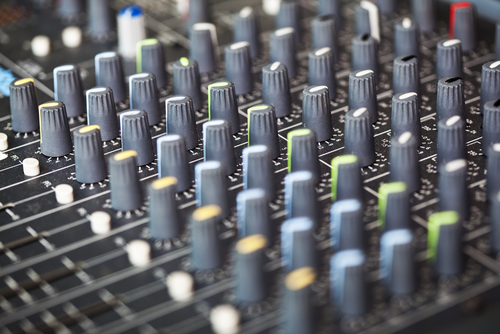 [This article was written by guest contributor Alex Andrews of Ten Kettles Inc.]
[This article was written by guest contributor Alex Andrews of Ten Kettles Inc.]
The goal of this article is to get you, the musician reader, quickly familiar with audio and EQ so you can turn around and improve your own sound—and your band’s sound—today. If you’ve ever wrestled with a muddy tone, a vocal sound that’s being covered up by the band, or a loud but somehow indistinguishable bass track, you’ll want to read on.
After hitting some audio basics, we’re going to EQ a guitar track in a few different ways. We’ve got lots of audio samples, colorful graphs, and practical examples to make this easy and useful. When you’re done with this article you’ll have built some knowledge you can use. I’m talking about being able to say “Hey, the guitar on that track is covering up the vocals, let’s cut some upper-mids.” That’ll be you. Alright, let’s get started.
The background
Let’s start with the basics. Take a listen to this train. It’s one of Ontario’s big green and white trains going by in the distance. The train itself sounds pretty rumbly, and in audio-speak, you could say it’s got a lot of “lows” or a big “low-end.”
[audio mp3=”https://diymusician.cdbaby.com/wp-content/uploads/2015/05/01-ShortTrain.mp3″][/audio]
Below is what it looks like as a picture:


That term “lows” means low frequencies. Every sound is made of up low frequencies (like you heard from that train), high frequencies (like the birds on that track), and everything in between. Pick up a bass guitar, you’ll get lots of lows; start hitting keys on the high-end of your piano, you’ll get some highs.
Here’s another sample. It’s me strumming a guitar.
This one’s not as obvious—you can’t really say it’s particularly heavy on the lows or highs compared to that train. Let’s see what the sound looks like (this picture is called a “frequency spectrum,” by the way):
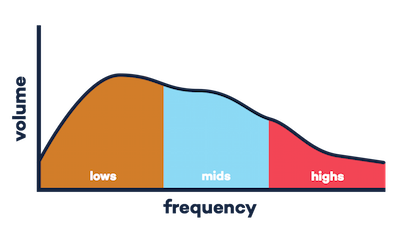

So, sounds aren’t just made up of lows or highs: they’re made up of a mix of frequencies. Even that train had some highs (though not much). Playing with that mix of lows, highs, and mids is one huge way we can perfect our sound as musicians. And that brings us to the EQ.
Telephone companies… to the rescue?
An equalizer (EQ) is a tool that lets you change your sound by turning up or down the highs, mids, and lows. Want to turn down the mids in that guitar recording? We’ll do that soon, but first let’s go back in time for two paragraphs. We don’t often have love to spare for telephone companies, but here’s an exception…
A long time ago, there was a person who received a phone call from far away—let’s call her Margaret. We’ll never know what it was about, but we do know that the sound quality was terrible. Since the sound needed to travel through so much wire to get from the caller all the way to Margaret, it had started to weaken at some frequencies. Maybe it lost some of its high frequencies, some of its lows, or some combination, but either way it sounded bad. Margaret was not happy.
The phone companies obviously wanted to fix this problem. So, they asked their engineers to come up with a fancy tool that would turn up those frequencies that were dying out over long-distance calls. Because their goal was to make the sound “equal” at both ends of the phone line, the tool was called an equalizer. Phone users rejoiced, and it wasn’t long until the EQ made its way into music.
Interestingly, the equalizer (or EQ) is often used for the exact opposite purpose in music. Instead of trying to make a recording sound equal to the original sound, we usually want to change it up and make it sound even better. The EQ can be used to make a vocal track sound less nasal, a guitar track more warm, or a band sound more cohesive (though it has its limits!). The best part is that EQs are everywhere. Guitar amps have them, audio recording software has them… even iTunes has one (as of iTunes 12, just click Window->Equalizer).
Let’s EQ some guitar
Alright, now that you know what highs and lows sound like—and the EQ’s origin story too—we’re going to EQ that guitar track. First, we’ll throw in some crazy settings and then go over some specific examples for singer-songwriters and bands. Then we’ll talk about how the humble EQ can be a big relationship-saver too.
One instrument, many frequencies
Here’s another short sample of me strumming guitar. You’ll also find a picture of an EQ, just like the one you’d see in iTunes. You can see that it’s completely flat—each “slider” is set to zero—which means no EQ effect is applied.
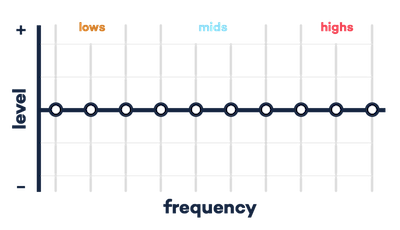

We’re going to use the EQ to change the frequencies in that guitar track. Let’s start with some obvious changes just to get our feet wet.
Highs. Here’s what happens if we really emphasize the highs. You can see on the EQ that we turned up the frequencies on the right—the highs—and turned down everything else.
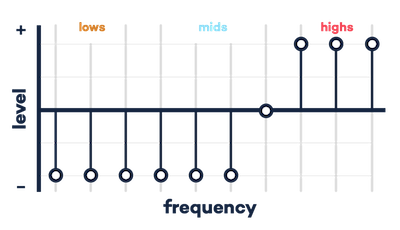

Lows. And here’s what it sounds like if we strip away the highs and mids, leaving mostly lows:


Mids. And finally, let’s emphasize those mids. This one sounds pretty boxy.
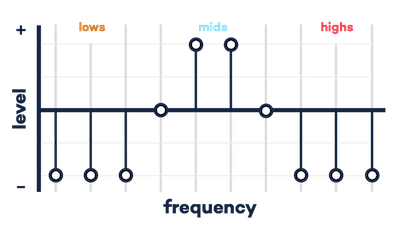

These are all extreme changes just so you can hear what a guitar’s “highs,” “lows,” and “mids” really sound like. But the real question is: as musicians, how do we actually use this stuff?
Bigger is better… sometimes
As a performing or recording musician, there are a few different ways you might want to EQ that guitar track. Say you’re a singer-songwriter, and do a lot of recording with just guitar and vocals. In that case, you’ll likely want a pretty full and warm sound for your guitar track. Why? With only two instruments (guitar, vocals), there’s a lot of room in that frequency spectrum to fill.
Singer/songwriter. To get that full sound, you might turn down the highs a little and turn up the lows. This will make the sound bigger without being too abrasive. By cutting out some of the upper-mids, you’ll leave room for the vocals too.
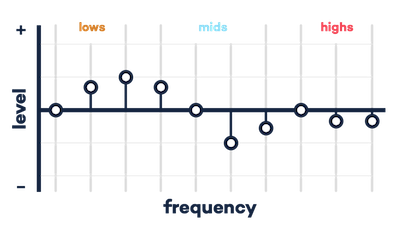

In a band. On the other hand, maybe you play in a big band. In that case, you might actually want a slightly thinner guitar sound that’ll fit well with the other instruments. Here we take out some of the low-end to make room in the mix for the bass guitar. We also trim out some of the upper-mids again to leave space for vocals.


Compared to the “singer/songwriter” sample, this one sounds pretty light-weight on its own, even a little thin. That makes sense because this track isn’t meant to be played on its own, it’s meant to be played with a band. The moral of the story is this: if you’re playing in a band, then EQ your instrument to sound good when everyone’s playing. If you find yourself constantly adjusting your volume but it never sounding quite right, try spending some time with your EQ.
EQ saves relationships
Have you ever gotten into a “You’re too loud! / No I’m not!” argument at band practice? You know, when a player wants to be louder, but the rest of the band wants her or him to turn down because it’s drowning everyone out? It can get out of hand fast, because everyone thinks they have a valid point. And here’s the thing: they’re all totally right. Everyone in the band needs to be able to hear themselves. But there’s a good chance the problem here isn’t just volume—it could be EQ too. A poorly-EQ’d sound will never be the right volume. So, to dial up the band love, give some focus to EQ levels before jumping to the volume knob.
What’s next
In this article, the goal was to demonstrate what EQ is all about and to give you some practical tips on how to put it to use. How did we do? Let us know in the comments.
So, what’s next? If you’re convinced that learning EQ is for you, then check out our video below for some more examples and to learn about our 99¢ ear-training app, HearEQ. And if you want some EQ tips for your next show, then you may want to read “Make your shows shine with these simple EQ tricks.”
Enjoyed the article and want to read more about audio (and what it’s like to run a music startup)? Then you’ll want to sign up for our newsletter, and you can find us on Twitter and Facebook too. Happy EQing.
hearEQ: Ear training for musicians, engineers, and audio lovers from Ten Kettles on Vimeo.
Alex Andrews is an engineer (B.Sc. Engineering Physics, M.Sc. Electrical Engineering), active musician, and runs an indie app company called Ten Kettles. Based in Toronto, Canada, Ten Kettles focuses on apps for music education. Their newest app, Waay, is for songwriters who want to learn music theory—and it’s gamified too. You can find out more at http://www.tenkettles.com.